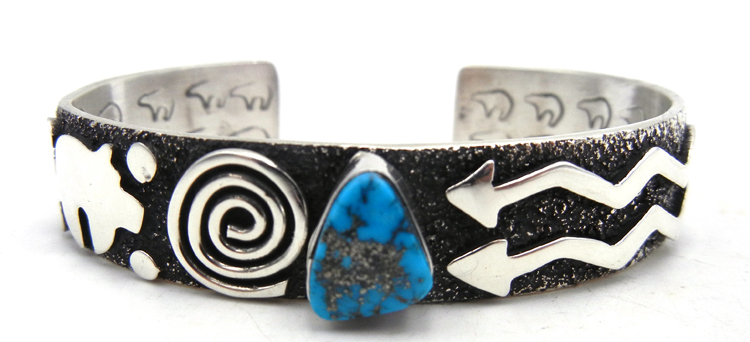Each Pueblo tribe has a different technique they specialize in when it comes to crafting Native American jewelry. From vintage Hopi earrings to Zuni necklaces, each authentic artisan-made piece is intricately crafted using techniques passed down and perfected across generations.
At Palms Trading Company, we have over 133 years of combined experience selling and trading authentic, handmade jewelry and art. As experts in vintage Native American jewelry, we‘re familiar with the styles and methods used to create these southwestern treasures.
Below, we’ve explained the different techniques used to craft different forms of Native American jewelry and their connection to various Pueblo tribes.
A Fusion of Cultures From Various Pueblos
Native American jewelry is a deep-rooted expression of beautiful cultures, history, and artistry.
There’s an extensive background behind making this art form that involves ancient practices and intricate designs. Familiarizing yourself with these common techniques allows you to better appreciate the workmanship that goes into these handmade pieces.
The art of silverwork has a particularly fascinating history in Native American culture. Silverwork is a relatively new trade among southwest Native Americans, taught by the Spanish and Mexicans in the 19th century.
The Navajo people were the first to embrace silversmithing and paved the way for the distinctive styles we now associate with Native American jewelry in the southwest.
Over time, the Zuni, Santo Domingo, and Hopi tribes have each contributed their unique styles and techniques to the world of southwest jewelry, creating a diverse and captivating array of masterfully executed pieces.
Techniques Used in Authentic Native American Jewelry
Stamping
Stamping is a silversmithing technique where a design is imprinted onto a piece of silver.
In this method, each artist uses a specific stamp, giving their work its own distinct and unique character. In this process, the stamping tool is stationary, unlike chasing, where the tool moves through the process. This means that the artist must strategically position the stamp over the silver surface and apply pressure to create the desired design.
Stamping is commonly employed by Navajo artists.
Repousse
This jewelry-making technique involves hammering on the reverse side of a piece, causing the other side to rise or be embossed. This practice adds dimension and depth to metal pieces, creating a stunning visual effect.
It’s a time-honored method that requires precision and craftsmanship to create the intricate patterns and textures often seen in Native jewelry.
Sandcast
Sandcasting is a unique method where sterling silver is heated until it turns into a liquid form and is then poured into a mold carved from hard sandstone.
The mold is secured with wet buckskin, which shrinks as it dries, forming a tight binding around the mold.
Once cooled, the piece of jewelry is meticulously sanded down to remove any imperfections, eventually being polished to a brilliant luster.
The patterns and shapes seen in these pieces are often organic, flowing, and inspired by the natural world, mirroring the landscapes of the Southwest. This method is commonly used by Navajo artisans.
Inlay
Inlay is a distinctive style where multiple stones are set in a particular pattern or design.
These stones can be lined up in a row or in a bowlike design, creating a striking “channel inlay” effect. Inlaid designs are commonly associated with Zuni jewelry and famous Zuni jewelry makers.
Overlay
Overlay techniques are often seen in Hopi jewelry designs.
This process involves using 2-3 separate sheets of silver, which are soldered together and finished to create a striking contrast between a polished silver background and a prominent black inset image.
The images are normally of clan symbols represented by various animals, kachinas, or other symbols important to the traditions of the Hopi people.
Like with stamped jewelry, Hopi jewelry makers use their own specialized tools, which give each jeweler’s piece a unique look.
Platero
This technique involves crafting a piece from numerous separate components that are soldered together.
Many platero pieces are set with multiple stones. The squash blossom necklace is a popular example of this style, highly sought after for its intricate craftsmanship. This method is commonly associated with the Navajo.
Fetish Necklaces
Authentic Zuni fetish necklaces are known for their intricacy. These necklaces consist of numerous hand-carved fetishes, typically representing various animals and made from various semi-precious stones.
While you might come across fetish bracelets, necklaces are the most prevalent and cherished form of this handmade jewelry.
Heishi
Heishi jewelry is unique to the Santo Domingo Pueblo Native Americans of New Mexico.
This style primarily comprises stone and shell, with minimal use of silver, bound together by sinew. It is reminiscent of the jewelry created by the Anasazi, adding a touch of ancient history to contemporary pieces.
These beloved jewelry pieces are excellent for minimalistic and natural aesthetics.
Browse Our Vast Selection of Native American Jewelry for Sale
At Palms Trading Company, we offer the largest selection of authentic jewelry from Indigenous artisans, representing the diverse styles and techniques discussed above. We invite you to explore our extensive collection online and discover your favorite style from our collection.
We also have a local store in Albuquerque if you want to take a look at these beautiful pieces in person. Our friendly staff is happy to assist you in finding a piece you’ll love.
Check out our vast selection of Native American jewelry to find your favorite style today!



